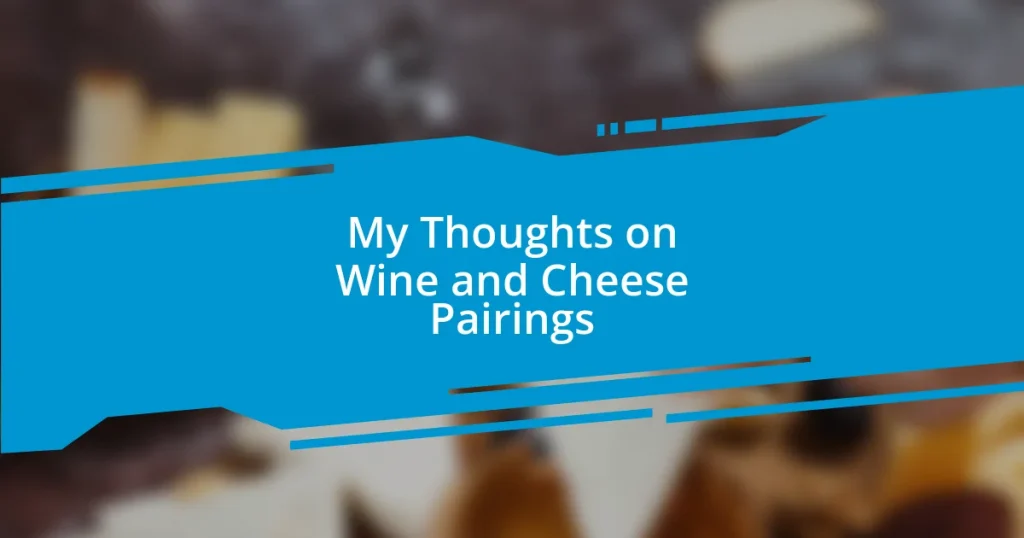Key takeaways:
- Pairing wine and cheese is an art that involves balancing flavors, textures, and intensities to elevate the tasting experience.
- Regional pairings enhance authenticity and celebrate local flavors, creating memorable culinary journeys.
- Experimentation with unique combinations can lead to delightful surprises and enrich the overall tasting adventure.

Understanding wine and cheese pairing
Pairing wine and cheese is both an art and a science that speaks to my passion for flavor combinations. I remember one cozy evening when I tried a creamy Brie with a crisp Chardonnay; the refreshing acidity of the wine perfectly cut through the rich creaminess of the cheese, creating a delightful balance. Isn’t it fascinating how the right pairing can elevate a simple snack into a gourmet experience?
Understanding this relationship involves recognizing how flavors interact. For instance, the saltiness of blue cheese contrasts beautifully with the sweetness of a dessert wine, enhancing both components. Don’t you find it intriguing how one sip can completely change your perception of a cheese?
To truly master the craft of pairing, I’ve learned to consider texture and intensity. A sharp cheddar might overpower a light Pinot Grigio, while a robust Cabernet Sauvignon could stand strong alongside it. It’s a puzzle that challenges my palate, inviting experimentation. What have your favorite combinations been?

Basic principles of pairing flavors
Pairing flavors is like a dance; it’s all about finding harmony between different elements. From my experience, a fundamental principle is matching intensity. For instance, consider how the bold flavors of an aged Gouda play beautifully with a full-bodied Merlot. The depth of the cheese and wine enhances each bite, creating a memorable experience that resonates long after the last sip.
- Balance: Seek complementary flavors; a sweet wine can elevate salty cheeses.
- Contrast: Sometimes opposites attract, like a rich cheese with a crisp, acidic wine.
- Texture: Pair creamy cheeses with wines that cleanse the palate, enhancing the overall enjoyment.
- Regional Pairing: Often, local wines and cheeses are crafted to go together, making them a natural match.
Reflecting on my own journey, I recall trying a fresh goat cheese with a citrusy Sauvignon Blanc; it was like sunshine on my palate. The brightness of the wine cut through the tanginess of the cheese, and I felt an instant connection. That moment was a revelation, reminding me that the right pairing transcends mere taste—it creates a narrative, a memory that lingers.

Choosing the right wine
Choosing the right wine can feel overwhelming at times, but I’ve found that focusing on the characteristics of the cheese is key. For example, when I paired a nutty Gruyère with a smooth Riesling, the result was pure pleasure. The wine’s sweetness complemented the cheese’s earthiness, creating a balance that danced beautifully on my palate. It’s moments like these that remind me how the right wine can uncover new layers of flavor in familiar cheeses.
Another important aspect is considering the occasion and company. I once hosted a gathering where we served a tart goat cheese alongside a delightful Sauvignon Blanc. The lively acidity of the wine sparked conversations and laughter, making the dish memorable and enjoyable. Choosing a wine that resonates with the vibe of your event truly enhances the overall experience.
Ultimately, my guiding principle is to trust your taste buds. I remember a time when I didn’t think a bold Sangiovese would go well with a creamy Camembert. To my surprise, the wine’s robust structure and the cheese’s richness formed an unexpected yet satisfying synergy. This taught me that sometimes, breaking the rules leads to the most delightful surprises.
| Cheese Type | Recommended Wine |
|---|---|
| Brie | Chardonnay |
| Blue Cheese | Port |
| Aged Gouda | Merlot |
| Goat Cheese | Sauvignon Blanc |
| Sharp Cheddar | Cabernet Sauvignon |

Selecting complementary cheeses
Selecting the right cheeses for your wine pairing can truly elevate your tasting experience. I remember an evening when I impulsively chose a creamy Brie to accompany a fruity Pinot Noir. The cheese melted beautifully on my tongue, while the wine’s bright notes highlighted its richness. How could something so simple feel so luxurious?
When you choose complementary cheeses, think about their textures and flavors. A firm cheese like Manchego can create a delightful contrast with a light-bodied white, while a pungent Roquefort can harmonize beautifully with a sweet dessert wine. Have you ever felt that thrilling moment when a flavor combination just clicks? It’s almost like a lightbulb going off, revealing new dimensions to both the cheese and the wine.
Also, consider how the cheese’s milk type influences its pairing potential. For example, I once paired a luscious sheep’s cheese with a zesty sparkling wine. The combination was a revelation; the cheese’s natural sweetness danced with the wine’s effervescence, creating a symphony of taste that sparked joy. I mean, is there anything better than discovering an unexpected pairing that feels as though it was meant to be?

Regions and their classic pairings
Exploring wine and cheese pairings by region has opened my eyes to exciting combinations that reflect local flavors. Take the classic pairing of a sharp Cheddar from England with a rich, full-bodied Cabernet Sauvignon. I recall savoring this combination during a chilly evening in London; the wine’s robust character beautifully contrasted the cheese’s intense flavor, creating a sense of warmth and comfort that lingered long after the last bite.
In Italy, the marriage of Pecorino Romano and Chianti evokes a sense of authenticity. I still remember my first taste of this pairing while enjoying a rustic meal in a quaint restaurant in Tuscany. The wine’s acidity cut through the saltiness of the cheese, bringing out the herbaceous notes in both and encapsulating the spirit of Italian cuisine. Isn’t it amazing how a simple meal can transport you to another place entirely?
Then there’s France, where creamy and tangy Camembert finds its perfect match in a crisp, fruity Chardonnay. I once hosted a picnic with friends in a sunlit garden, featuring this classic combo. As we laughed and clinked glasses, the delightful pairing became more than just food—it turned into a moment of connection that made the experience unforgettable. How often do our taste buds lead us to create lasting memories?

Experimenting with unique combinations
One of the most thrilling aspects of wine and cheese pairing is the joy of discovering unexpected combinations. I remember one evening when I experimented with a bold blue cheese and a sweet Riesling. At first, I was hesitant, thinking the strong flavor of the cheese might overpower the wine, but the result was captivating. The cheese’s creaminess intertwined perfectly with the wine’s sweetness, creating a balance that took me by surprise. Have you ever tried something daring just for the fun of it?
Sometimes, the most memorable pairings come from stepping outside conventional boundaries. On a whim, I paired a spicy goat cheese with a hoppy IPA during a casual gathering. The sharpness of the cheese played beautifully against the bitter notes of the beer, turning my simple snack into an exciting flavor adventure. It’s moments like these that remind me how pairing isn’t just about tradition; it’s about pushing the limits of our palates and finding joy in the unexpected.
I also love exploring global flavors when pairing wine and cheese. Once, I joined friends for a themed tasting night where we matched Japanese sake with aged Gouda. The nutty richness of the cheese complemented the delicate, smooth notes of the sake in a way that felt both surprising and delightful. Isn’t it fascinating how a pairing can tell a story about culture and personal experiences, making each bite and sip feel like a journey?

Tips for perfect pairing occasions
Finding the right occasion for wine and cheese pairing can elevate the experience beyond just taste; it creates a feeling. I recall one evening spent with friends around a fire pit. We chose a light Sauvignon Blanc paired with creamy goat cheese and fresh figs. That delightful balance made not just our palates dance but also fostered conversations that flowed as freely as the wine. Isn’t there something magical about how the right setting can enhance flavors and relationships?
Consider the season, too. I once hosted a summer garden party featuring a refreshing rosé alongside a vibrant spread of fresh mozzarella and basil. The bright flavors of the cheese and herbs mimicked the joy of a sunny afternoon, creating an atmosphere that encouraged mingling and laughter. Do you see how a pairing can mirror the time of year, adding layers to the experience?
Lastly, don’t shy away from theme-based gatherings. I organized a “Around the World” tasting night once, pairing French Brie with a soft, fruity Beaujolais, while also serving Spanish Manchego with a bold Tempranillo. Each distinct pairing not only showcased global flavors but also sparked dialogue about our shared travels and dreams. How often do we let our food and drink prompt stories and laughter that linger long after the last sip?














